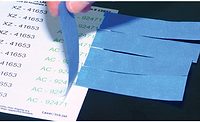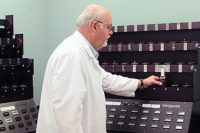
Figure 1. Single- and Twin-Column Materials Testing Machines

Figure 2. Test Jig Showing 90° Peel Test on a Pressure-Sensitive Barcode Label
Careful attention to sample preparation is essential for making accurate measurements. Many standards specify precisely how the samples are to be prepared for testing to ensure that the adhesives under test are prepared exactly how they are used in their real applications. Areas covered can include the preparation of surfaces before adhesive application, using the correct mixing conditions, using the correct application conditions (e.g., rate of spread and thickness of applied adhesive), assembly conditions (e.g., pressure, temperature and time), and curing conditions. Typical test measurements include:
- 180°, 90° and T-peel tests
- Lap shear tests for evaluating the shear strength of adhesives for bonding two surfaces together and welds such as metal and plastic
- Coating cohesion (i.e., adhesion or bond strength of a coating to a substrate such as paint or varnish)
- Tackiness
- Stringiness
- Creep
- Cure behavior
- Bond strength
- Seal strength, peel strength and adhesion strength tests to determine adhesion strength of flexible plastic packaging

Figure 3. General Peel Test with Load Averaging Between User-Defined Points
Materials Testing Machines
Universal materials testing machines are available in single- or twin-column versions and allow precisely controlled tensile or compression forces to be applied to the sample over a controlled period of time in order to determine its physical and mechanical properties (see Figure 1, p. 31). Precision loadcells measure the extension or compression of the material under test as a function of force or time.Materials testing machines are available in a wide range of sizes, enabling different force ranges to be applied. The maximum force applied by an individual instrument typically ranges from 225 lbf (1 kN) to 3,372 lbf (150 kN), so the most appropriate testing machine can be chosen for the required application.
Universal testing machines can be adapted to make a wide range of measurements by using a variety of grips and fixtures that enable the samples to be held so that the forces can be applied in different ways. Any individual materials testing machine could make any of the measurements listed previously (within its specific force range limits) simply by using the appropriate grip or fixture.
Most materials testing machines offer PC control, and sophisticated control and data analysis packages are available. Software control allows the user to program the machine to perform the test exactly as prescribed by the particular standard being used, which ensures repeatable testing.
Software control offers additional potential benefits. Sample preparation instructions can be included, displayed on the test setup screen and the software configured so that the user has to acknowledge that the appropriate sample preparation has been done before the test can be initiated. In addition, post-test observations are often required once the test has been completed, and it may be that a failure description code and/or images taken of the samples after testing need to be appended to the test results. Software can build the appropriate codes into a drop-down menu. Built-in security and audit trails can ensure test data security and traceability.
Peel Strength Testing
Peel strength testing is particularly important for testing the permanence of adhesion or peelability of self-adhesive (pressure-sensitive) labels, whether it is important that a label can be easily removed (e.g., after purchase of a product) or not (e.g., to prevent labels from expensive products being switched to cheaper varieties or for security applications). FINAT test methods FTM 1 and FTM 2 are standards for 180° and 90° peel tests. Peel adhesion is defined as the force required to remove pressure-sensitive coated material that has been applied to a standard test plate under specified conditions from the plate at a specified angle and speed. Full details of the methods can be found in the eighth edition of the FINAT Technical Handbook.1Tests are carried out at low force (typically less than 22.5 lbf, or 100 N) using a suitable materials tester equipped with low-force vice grips capable of holding samples 25 mm wide. For the 180° peel test, it is recommended that a pneumatic grip be used with a sample alignment gauge positioned on the jaws of the grip for optimum reproducibility. The lower vice is mounted on the base of the materials tester and holds the substrate plate while the upper grip holds the sample label, with the two vices aligned so that the angle of peel is 180°. The jaw separation rate is set to 300 mm/min. Tests are carried out after the label has been applied to the plate for 20 minutes. A second set of tests is carried out on samples that have been prepared for 24 hours, which is the length of time considered to provide the ultimate adhesion.
The 90° peel test differs from the 180° peel test in that it can allow the end user to compare how different laminates can be repositioned. Measuring peel adhesion at 90° normally gives a lower value than at 180° and is better-suited for more fragile materials that normally result in paper tear. For 90° testing, the upper vice grip is used as before, but the lower vice grip is replaced with a grip featuring a low-friction sliding table that maintains the 90° angle constant throughout the test (see Figure 2).
For larger samples, such as laminated panels that are bonded together, the T-peel test is used, following standard ASTM D 1876-012. In this test, two laminate test panels (6 x 12 in.) are bonded together over approximately 9 in. of their length. The two unbonded sections are peeled back from each other to the point where the bond begins, resulting in a “T” shape. Using similar grips to those used for the 180° peel test, one of the unbonded sections is mounted in the lower grip while the other is mounted in the upper grip. The load is applied at a constant speed of 10 in./min to peel the layers apart.
Other frequently used ASTM standards for peel testing include ASTM D 903-98(2010) for the determination of the comparative peel or stripping strength characteristics of adhesive bonds and ASTM D 3807-98(2004) for determining the strength properties of adhesives in cleavage peel by tension loading, which enable the comparative testing of cleavage/peel strengths of bonded engineering thermoplastic adherends. Example peel test results are shown in Figures 3 and 4.

Figure 4. Multiple Peaks Peel Test with Peak Definition
Bond Strength Testing
Bond strength generally involves determining the stress required to rupture a bond formed by an adhesive between two metal blocks. Bond testing is a tensile test where the force is applied perpendicular to the bonded surfaces.ASTM D 897-012 describes a bond testing procedure. Bond testing can be carried out using a set of grips that feature a pair of bobbins. This fixture consists of two bobbin holders with a slot in the shoulder to allow the bobbins to be easily inserted. The adhesive to be tested is applied to the square surface of each bobbin. The bobbins, which can be made from a variety of metal materials, are held together until the adhesive is set; the assembly is then slid into the slots of each holder and the tensile test performed. As mentioned previously, it is critical for accurate results that the adhesive is mixed, applied and cured exactly according to the manufacturer’s recommendations.
The maximum load at the point the bond breaks is recorded. After the test is completed, a visual inspection is used to evaluate the percentage of cohesion, adhesion and contact failures on the separated surfaces.
The force required for the test (and therefore the size of materials testing machine needed) is completely determined by the strength of the adhesive being tested. Bond strength testing is used in both product development and quality control applications.
Lap Shear Testing
Lap shear can be determined through either tensile or compression testing, which are used for identifying adhesive strengths, surface preparation parameters, and adhesive environmental durability. This type of test is employed to evaluate adhesives used in a wide range of industries, including plastics, glass, tape, metals, wood, etc., and standards are applicable to these different industries:- ASTM D 3166-992, Standard Test Method for Fatigue Properties of Adhesives in Shear by Tension Loading (Metal/Metal)
- ASTM D1002-102, Standard Test Method for Apparent Shear Strength of Single-Lap-Joint Adhesively Bonded Metal Specimens by Tension Loading (Metal-to-Metal)
- ASTM D 31632, applies to plastics joints
- ASTM D 58682, used for fiber-reinforced plastics (FRP) against itself or metal
Ensuring Quality
Governed by international standards, quality testing programs ensure that new products are checked rigorously for performance and safety before reaching the supply chain. Testing also helps manufacturers establish maximum return on investment by remaining efficient and cost effective. The challenge is to simulate the real- life behavior of adhesives within the confines of a laboratory or quality control area.Materials testing is a well-established testing technique for the adhesives industry. The universal nature of the machines, coupled with a wide selection of grips and fixtures, means that a number of bonded items-from rubber and plastics to composites and metals-can all be tested to internationally recognized standards using the same machine.
For additional information, contact Lloyd Instruments Ltd. at Steyning Way, Bognor Regis, West Sussex, PO22 9ST, UK; phone (44) 1243-833370; fax (44) 1243-833401; email carl.bramley@ametek.co.uk; or visit www.lloyd-instruments.com.
Reference
1. www.finat.com/templates/mercury.asp?page_id=1553Editor’s note: Copies of complete standards may be purchased from ASTM International: phone (610) 832-9585, email service@astm.org or visit www.astm.org.


